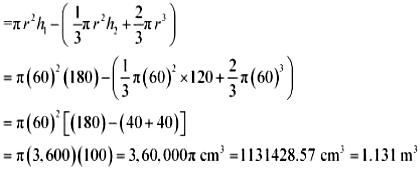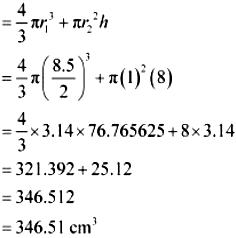16. A solid consisting of a right circular cone of height 120 cm and radius 60 cm standing on a hemisphere of radius 60 cm is placed upright in a right circular cylinder full of water such that it touches the bottom. Find the volume of water left in the cylinder, if the radius of the cylinder is 60 cm and its height is 180 cm. [Use \(\pi\) = 22/7]
Answer:

Radius (r) of hemispherical part = Radius (r) of conical part = 60 cm
Height (h2) of conical part of solid = 120 cm
Height (h1) of cylinder = 180 cm
Radius (r) of cylinder = 60 cm
Volume of water left = Volume of cylinder − Volume of solid
= Volume of cylinder - (Volume of cone + Volume of hemisphere)

17. A spherical glass vessel has a cylindrical neck 8 cm long, 2 cm in diameter; the diameter o the spherical part is 8.5 cm. By measuring the amount of water it holds, a child finds its volume to be 345 cm3 . Check whether she is correct, taking the above as the inside measurements, and π = 3.14.
Answer:

Height (h) of cylindrical part = 8 cm
Radius (r2) of cylindrical part = 1 cm
Radius (r1) spherical part = 4.25 cm
Volume of vessel = Volume of sphere + Volume of cylinder

Hence, she is wrong.
18. A metallic sphere of radius 4.2 cm is melted and recast into the shape of a cylinder of radius 6 cm. Find the height of the cylinder.
Answer:
Radius (r1) of hemisphere = 4.2 cm
Radius (r2) of cylinder = 6 cm
Let the height of the cylinder be h.
The object formed by recasting the hemisphere will be the same in volume.
Volume of sphere = Volume of cylinder

Hence, the height of the cylinder so formed will be 2.74 cm.
19. Metallic spheres of radii 6 cm, 8 cm, and 10 cm, respectively, are melted to form a single solid sphere. Find the radius of the resulting sphere.
Answer:
Radius (r1) of 1st sphere = 6 cm
Radius (r2) of 2nd sphere = 8 cm
Radius (r3) of 3rd sphere = 10 cm
Let the radius of the resulting sphere be r.
The object formed by recasting these spheres will be same in volume as the sum of the volumes of these spheres.
Volume of 3 spheres = Volume of resulting sphere

Therefore, the radius of the sphere so formed will be 12 cm.
20. A 20 m deep well with diameter 7 m is dug and the earth from digging is evenly spread out to form a platform 22 m by 14 m. Find the height of the platform. [Use \(\pi\) = 22/7]
Answer:

The shape of the well will be cylindrical.
Depth (h) of well = 20 m
Radius (r) of circular end of well = 7/2 cm
Area of platform = Length × Breadth = 22 × 14 m2
Let height of the platform = H
Volume of soil dug from the well will be equal to the volume of soil scattered on the platform.
Volume of soil from well = Volume of soil used to make such platform
\(\pi \) x r2 x h = Area of platform x Height of platform

Therefore, the height of such platform will be 2.5 m.
21. A well of diameter 3 m is dug 14 m deep. The earth taken out of it has been spread evenly all around it in the shape of a circular ring of width 4 m to form an embankment. Find the height of the embankment.
Answer:

The shape of the well will be cylindrical.
Depth (h1) of well = 14 m
Radius (r1) of the circular end of well = 3/2 m
Width of embankment = 4 m
From the figure, it can be observed that our embankment will be in a cylindrical shape having outer radius (r2) as 4+ (3/2) = 11/2 m and inner radius (r1) as 3/2 m.
Let the height of embankment be h2.
Volume of soil dug from well = Volume of earth used to form embankment

Therefore, the height of the embankment will be 1.125 m.
22. A container shaped like a right circular cylinder having diameter 12 cm and height 15 cm is full of ice cream. The ice cream is to be filled into cones of height 12 cm and diameter 6 cm, having a hemispherical shape on the top. Find the number of such cones which can be filled with ice cream.
Answer:
Height (h1) of cylindrical container = 15 cm
Radius (r1) of circular end of container = 6 cm
Radius (r2) of circular end of ice-cream cone = 3 cm
Height (h2) of conical part of ice-cream cone = 12 cm
Let n ice-cream cones be filled with ice-cream of the container.
Volume of ice-cream in cylinder = n × (Volume of 1 ice-cream cone + Volume of hemispherical shape on the top)

Therefore, 10 ice-cream cones can be filled with the ice-cream in the container.
23. How many silver coins, 1.75 cm in diameter and of thickness 2 mm, must be melted to form a cuboid of dimensions 5.5 cm ×10 cm × 3.5 cm? [Use \(\pi\) = 22/7]
Answer:

Coins are cylindrical in shape.
Height (h1) of cylindrical coins = 2 mm = 0.2 cm
Radius (r) of circular end of coins = 1.75/2 = 0.875 cm
Let n coins be melted to form the required cuboids.
Volume of n coins = Volume of cuboids

Therefore, the number of coins melted to form such a cuboid is 400.